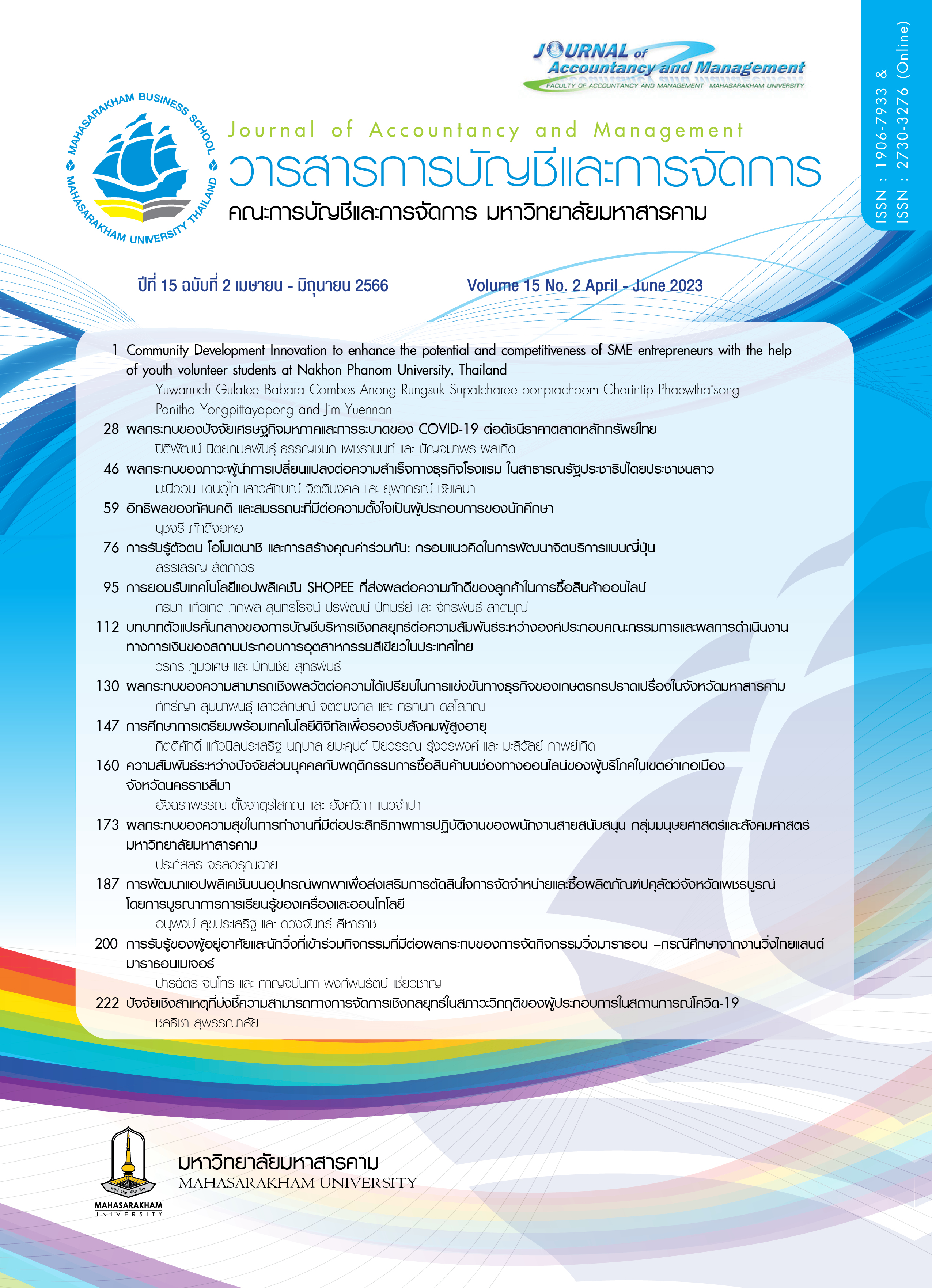ปัจจัยเชิงสาเหตุที่บ่งชี้ความสามารถทางการจัดการเชิงกลยุทธ์ในสภาวะวิกฤติของ ผู้ประกอบการในสถานการณ์โควิด-19
Main Article Content
บทคัดย่อ
จากสถานการณ์การแพร่ระบาดของไวรัสโคโรน่า 2019 ตั้งแต่ปลายปี พ.ศ.2562 เป็นต้นมา ส่งผลกระทบเชิงลบต่ออัตราการเติบโตทางเศรษฐกิจทุกภาคส่วนในประเทศไทย ธุรกิจส่วนใหญ่มีกำไรและเงินทุนลดลงอย่างรวดเร็ว ประกอบกับการระบาดระลอกใหม่ในช่วงส่งท้ายปีเก่า พ.ศ.2563 เปรียบเสมือนการซ้ำเติมให้ผู้ประกอบการพบกับภาวะที่ยากลำบากในการฟื้นตัวและยืนหยัดต่อในอุตสาหกรรม บทความวิชาการนี้จึงมีวัตถุประสงค์เพื่อศึกษา 1) ความหมายและองค์ประกอบของการจัดการเชิงกลยุทธ์ในสภาวะวิกฤติ และ 2) ปัจจัยเชิงสาเหตุที่บ่งชี้ความสามารถทางการจัดการเชิงกลยุทธ์ในสภาวะวิกฤติของผู้ประกอบการในสถานการณ์โควิด-19 อันจะนำไปสู่การธำรงรักษาตำแหน่งทางธุรกิจ ภายใต้การแสวงหาและใช้ประโยชน์จากโอกาส อุปสรรค หรือวิกฤติที่เกิดขึ้นอย่างชาญฉลาด ผลการวิเคราะห์ข้อมูลเป็นไปตามข้อสันนิษฐาน โดยพบว่า 1) การจัดการเชิงกลยุทธ์ในสภาวะวิกฤติ หมายถึง กลยุทธ์ที่ประยุกต์ใช้ในสถานการณ์พิเศษ เพื่อให้สูญเสียน้อยที่สุดและฟื้นฟูเร็วที่สุด ประกอบด้วย กลยุทธ์หลบหลีก กลยุทธ์แก้ปัญหา และกลยุทธ์เชิงรุก และ 2) ปัจจัยเชิงสาเหตุที่บ่งชี้ความสามารถทางการจัดการเชิงกลยุทธ์ในสภาวะวิกฤติ ได้แก่ 1) ความคงอยู่ของผู้ประกอบการ ประกอบด้วย คุณลักษณะเฉพาะตัว และทุนมนุษย์ 2) ประสิทธิภาพการทำงาน ประกอบด้วย ประสิทธิภาพด้านการบริหารงาน และประสิทธิภาพด้านพฤติกรรม และ 3) การจัดการคนเก่ง ประกอบด้วย การกำหนดความสามารถคนเก่ง การคัดเลือกคนเก่ง และการพัฒนาคนเก่ง
Downloads
Article Details

อนุญาตภายใต้เงื่อนไข Creative Commons Attribution-NonCommercial-NoDerivatives 4.0 International License.
บทความที่ได้รับการตีพิมพ์เป็นลิขสิทธิ์ของวารสารการบัญชีและการจัดการ
ข้อความที่ปรากฏในบทความแต่ละเรื่องในวารสารวิชาการเล่มนี้เป็นความคิดเห็นส่วนตัวของผู้เขียนแต่ละท่านไม่เกี่ยวข้องกับมหาวิทยาลัยมหาสารคาม และคณาจารย์ท่านอื่นๆในมหาวิทยาลัยฯ แต่อย่างใด ความรับผิดชอบองค์ประกอบทั้งหมดของบทความแต่ละเรื่องเป็นของผู้เขียนแต่ละท่าน หากมีความผิดพลาดใดๆ ผู้เขียนแต่ละท่านจะรับผิดชอบบทความของตนเองแต่ผู้เดียว
เอกสารอ้างอิง
ชลธิชา ทิพย์ประทุม จิราวรรณ คงคล้าย และวิโรจน์ เจษฎาลักษณ์. (2562). การพัฒนาโมเดลการสนับสนุนแรงเสริมและรางวัลภายในที่ส่งผลต่อพฤติกรรมความจงรักภักดีต่อองค์การและผลการปฏิบัติงานของพนักงานในอุตสาหกรรมซอฟต์แวร์ในประเทศไทย. วารสารการบัญชีและการจัดการ คณะการบัญชีและการจัดการ
มหาวิทยาลัยมหาสารคาม, 11(2), 214-229.
ชลธิชา ทิพย์ประทุม. (2562). การพัฒนาโมเดลความสำเร็จของระบบการจัดการความรู้เพื่อมุ่งสู่การเป็นองค์การสมรรถนะสูงของมหาวิทยาลัยราชภัฏจันทรเกษม. วารสารวิชาการ มทร.สุวรรณภูมิ ด้านมนุษยศาสตร์และสังคมศาสตร์, 4(2), 140-153.
พฤกษ์ สุพรรณนาลัย จิราวรรณ คงคล้าย และวิโรจน์ เจษฎาลักษณ์. (2561). ปัจจัยเชิงสาเหตุและผลลัพธ์ของการจัดการคนเก่งที่มีอิทธิพลต่อองค์กรประสิทธิภาพสูงในประเทศไทย. วารสารวิจัยและพัฒนา วไลยอลงกรณ์ ในพระบรมราชูปถัมภ์, 31(3), 21-30.
ศูนย์วิจัยกสิกร. (2563). ประมาณการรายได้ของธุรกิจร้านอาหารในปี 2563. ค้นเมื่อ 28 ตุลาคม 2563, จาก https://www.kasikornresearch.com/th/analysis/k-econ/business/Pages/z3090.aspx.
สำนักงานคลังจังหวัดสมุทรสาคร. (2563). สรุปผลการสำรวจแบบสอบถามภาวะเศรษฐกิจ. สำนักงานคลังจังหวัดสมุทรสาคร, กรมบัญชีกลาง.
สุภาวดี ธงภักดิ์ และสันติธร ภูริภักดี. (2564). แนวทางการปรับเปลี่ยนและพัฒนาการบริการของร้านอาหารที่เป็นมิตรกับสิ่งแวดล้อม “ร้านอาหารยามเย็น กรุงเทพมหานคร” ภายใต้สถานการณ์การแพร่รระบาดของเชื้อไวรัสโควิด 19”. วารสารศิลปศาสตร์และอุตสาหกรรมบริการ, 4(2), 761-772.
Amit, R., & Schoemaker, P. J. H. (1993) Strategic Asset and Organizational Rent. Strategic Management Journal, 14, 33-46.
Banger, R., Mashruwala, R., & Tripathy, A. (2014). Does a Differentiation Strategy lead to more Sustainable Financial Performance than a Cost Leadership Strategy? Management Decision, 52(50), 872-896.
Barney, J. (1991). Firm Resources and Sustained Competitive Advantage. Journal of Management, 17, 99-120.
Caliendo, M., Goethner, M., & Weibenberger, M. (2020). Entrepreneurial persistence beyond survival: Measurement and determinants. Journal of Small Business Management, 58(3), 617-647.
Campbell, J. P., Dunnette, M. D., & Hough, L. M. (1990). Handbook of industrial and organizational psychology. (2nd ed). CA, Palo Alto : Consulting Psychologist Press.
Chmiel, N., Fraccaroli, F., & Sverke, M. (2017). An Introduction to Work and Organizational Psychology. NJ : John Wiley & Sons.
De Waal, A. A. (2012). Characteristics of high-performance organizations. Journal of Management Research, 4(4), 39-71.
Dhani, P., & Sharma, T. (2017). Effect of Emotional Intelligence on Job Performance of IT employees: A gender study. Procedia Computer Science, 122, 180-185.
Freeland, R. E., & Keister, L. A. (2016). How does race and ethnicity affect persistence in immature ventures? .Journal of Small Business Management, 54(1), 210–228.
Fritsch, M., Brixy, U., & Falck, O. (2006). The effect of industry, region, and time on new business survival - A multi-dimensional analysis. Review of Industrial Organization, 28(3), 285–306.
Haimowitz, D., & Stefanacci, R.G. (2020). Crisis (Pandemic) management playbook for assisted living. Geriatric Nursing, 41, 498-500.
Holland, D. V., & Shepherd, D. A. (2013). Deciding to persist: Adversity, values, and entrepreneurs’ decision policies. Entrepreneurship Theory and Practice, 37(2), 331–358.
Kao, G. H. Y., Wang, S. W., & Farquhar, J. D. (2020). Modeling Airline Crisis Management Capability: Brand attitude, brand credibility and intention. Journal of Air Transport Management, 89, 1-9.
Kazadi, K., Lievens, A., & Mahr, D. (2016). Stakeholder co-creation during the innovation process: Identifying capabilities for knowledge creation among multiple stakeholders. Journal of Business Research, 69(2), 525-540.
Krungsri Research. (2020). Covid-19 Impact on the Thai Economy and Vulnerability of Thai Firms. Research Intelligence, April, 1-8.
Mahjoub, M., Atashsokhan, S., Khalilzadeh, M., Aghajanloo, A., & Zohrehvandi, S. (2018). Linking “Project Success” and “Strategic Talent Management”: satisfaction / motivation and organizational commitment as mediators. Procedia Computer Science, 138, 764–774.
McClelland, D. C. (1965). N achievement and entrepreneurship: A longitudinal study. Journal of Personality and Social Psychology, 1(4), 389-392.
Michaels, E., Handfield-Jones, H., & Axelrod, B. (2001). The War for Talent. Boston : Harvard Business School Press.
Milburn,T. Schuler, R., & Watman, K. (1983). Organizational crisis: definition and conceptualization. Human Relations, 36(12), 1141-1160.
Patel, P. C., & Thatcher, S. M. (2014). Sticking it out: Individual attributes and persistence in self-employment. Journal of Management, 40(7), 1932–1979.
Porter, M.E. (1980). Competitive Strategy. NY : Free Press.
Richard, O.C., Murthi, B.P.S., & Ismail, K. (2007). The impact of racial diversity on intermediate and long-term performance: The moderating role of environmental context. Strategic Management Journal, 28(12), 1213–1233.
Sahina, S., Ulubeylib, S., & Kazazaa, A. (2015). Innovative Crisis Management in Construction: Approaches and the Process. Procedia - Social and Behavioral Sciences, 195, 2298 – 2305.
Unger, J., Rauch, A., Frese, M., & Rosenbusch, N. (2011). Human capital and entrepreneurial success: A meta-analytical review. Journal of Business Venturing, 26(3), 341–358.
Vaiman, V., & Collings, D.G. (2013). Talent management: advancing the field. International Journal Human Resource Management, 24(9), 1737-1743.
Vardarlier, P. (2016). Strategic approach to Human Resources Management during Crisis. Procedia - Social and Behavioral Sciences, 235, 463 – 472.


